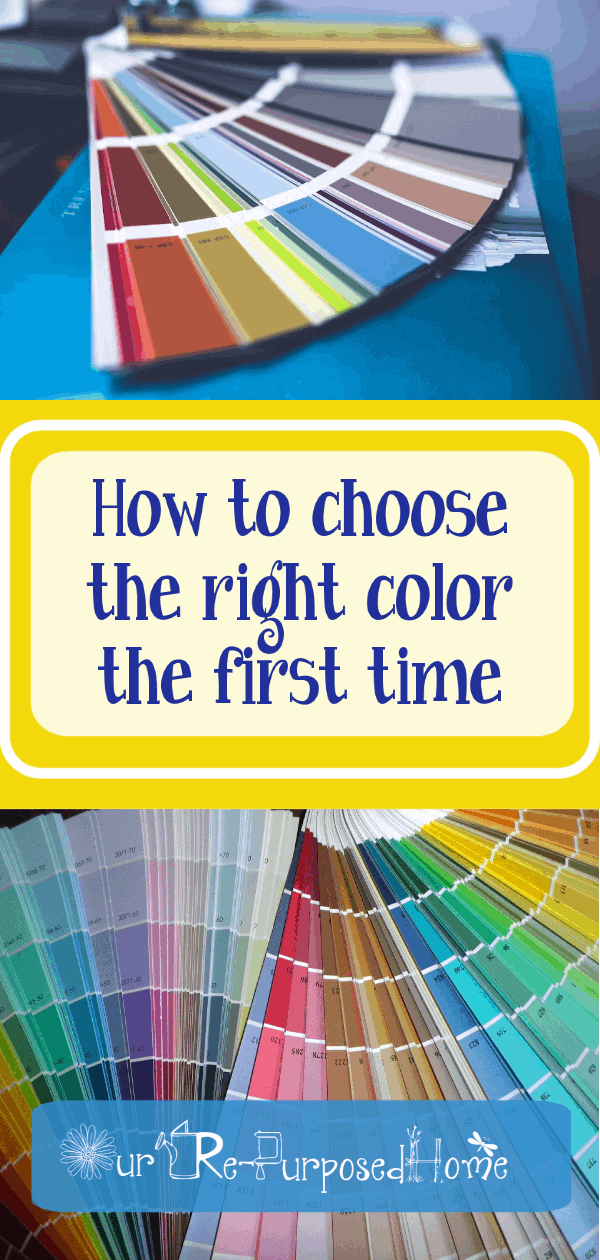How to Choose Paint Colors for your home
Have you ever picked out what you thought was the perfect paint color? Then you paint the whole room and hate it? Many of us have. So, if you want to choose the right paint color the first time, there are some things you need to understand before you buy your paint.
Choosing paint colors can be tricky and sometimes your favorite colors may not be the best choice for your walls. Below you will learn a few do’s and don’ts as well as a little lesson in color theory which will help you look at colors in a whole new light.
This post may contain affiliate links. If you choose to purchase a recommended product, I may receive a small commission at no additional cost to you. Rest assured that I will not recommend any product that I would not use myself. For our full policies and disclosures click here.
Lighting and color
Never choose the paint color at the paint store!
Light plays a huge role in how your color will look. When you’re looking at paint color chips in the hardware store you are seeing them under the light of the store; typically fluorescent. Fluorescent lights cast a blue light which will dramatically change how that color swatch looks to you. If you took that same swatch outside on a sunny day it will look a completely different color.
This is a big reason why you loved something in the store but not when you got it home!
Always, always, bring the color swatches home and look at them in the room that you are going to paint! Better yet, live with them on the walls for a few days. This way you can see how the color will react with different types of light. A sunny day vs. a rainy day. Daytime vs. night-time.
Even the direction your room faces will cast different colors of light that change at different times of the day. All of these circumstances will play a role in choosing the right paint color. You should make sure you still love the color under all of these lighting conditions before you commit to painting a whole room.
Lighting experiment
Here is an experiment to show you how light affects color. Notice the gray in the white square looks dark compared to the gray in the black square where it looks lighter. They are the exact same color, Gray. It’s the surrounding light or lack of it, that changes how the Gray looks.
This is a great example of why people get scared of a color being too dark when trying it on a white wall. Of course, the color is going to look dark next to white!
Here are some of the types of light the sun will cast depending on which direction your room faces.
North-facing rooms: The light in these rooms will feel cool and look bluish. Bolder colors will show up better than muted colors and lighter colors will look subdued.
South-facing rooms: Lots of light from this direction makes cool and warm colors look best. Dark colors will look brighter and lighter colors will feel warmer.
East-facing rooms: Eastern light is warm and yellow in tone in the morning then turns bluer in the afternoon. These are great rooms for reds, oranges, and yellows.
West-facing rooms: Evening light in these rooms is yellow and warm, but the morning light is scarce and can make colors look dull.
Here are some colors artificial light will cast in your room
Artificial light also casts different colors, or temperatures of color, into a room. So when trying to choose your paint color keep the following in mind. Here are some examples of artificial light and its colors.
Incandescent: This bulb light casts a warm, yellow glow and will make reds, oranges, and yellows more vivid, while muting blues and greens.
Fluorescent: This bulb light emits a cool light and can make blues and greens more rich while muting warm colors like red and yellow.
Halogen: This bulb resembles natural light and makes all colors look more vivid.
Compact fluorescent lights (CFLs): CFLs can produce either a warm white, neutral, or cool bluish-white light depending on which you choose at the store.
LEDs: You can buy warmer or cooler LEDs and even “smart” LED bulbs whose color you can control wirelessly. These can be great if you have an existing color that isn’t working at night. Just change the temperature of the bulb and your color will change.
If you look for bulbs that say “daylight” bulbs. That bulb will be very close to natural daylight and give your colors a “true” look.
Colors effect other colors
Other colors in the room will change the look of your paint.
When trying to choose the right paint color, one problem is that colors actually change depending on the colors around them. Well, the color doesn’t change, but the way we see it does.
If you have ever looked at a paint fan deck you would see that all the colors in that deck react to each other. For instance, if you look at a white paint swatch by itself… it looks white. But, if you put it next to a different white swatch they will look completely different. One may look like a warm, antique white, or maybe a cool, blue-white. But you won’t notice this difference by just looking at one white at a time. It’s all relative.
Look at this experiment. All of the little pink squares below are identical in size and color but look different.
The pink color may be the same but our eyes perceive it differently because of the neighboring color.
Even more interesting, look at the image below. See how the small squares of color look different with different colors behind them.

Here is a website that has some interesting facts about color in general. You may be surprised at just how color affects us. UCreative.com
So how does all of this affect the paint colors you choose for your home?
My own experience choosing a color
I painted my living/kitchen/dining/entryway yellow with white trim. I love yellow! I wanted it to be yellow which was welcoming and warm. What I got was a bright, bold, fluorescent yellow!
I loved the color…just not all over my walls! Not to mention when the sunlight changed in the room, so did the color. It went from an orange/yellow in the morning to a highlighter yellow in the afternoon. YIKES!
So, I picked another softer yellow and painted it again. And although it was better than the first color, I still didn’t love it. But, I liked it enough to live with it for a while.
So how did I finally choose the right paint color? First of all, I gave up on the yellow LOL. All kidding aside, I decided to change the wall color altogether and decided on a very soft, warm gray.
Now, when trying to choose my new paint color, I knew that I didn’t want to look at this color next to my yellow walls because I knew it would make the gray sample look “cool” next to the “warm” yellow. And I wanted a “warm” gray.
Or it could have made the gray look purplish next to the yellow which I also didn’t want. So I made sure I could see the true color by looking at it in front of my white built-ins instead of on the yellow walls.
Here’s how to pick the perfect paint color for your room
What “not” to do when choosing a color
This is what not to do…and this is exactly what most people do. Don’t tape that little paint sample up on the wall, next to the existing color! BAD IDEA!
Yes, it’s good to live with the color as I said before, but don’t put it near, or on, a color you are getting rid of. Think of the squares in the experiment above. Your literally doing the same thing!
Here’s a better idea to pick the perfect color
Paint a large square on the wall…preferably a white wall. Or, if you don’t want to paint the wall, paint a large poster board and hang it on the wall.
Now put your hands up next to your eyes (like horse blinders). Now you can look at the new color without seeing the old color with it. This will give you a truer sense of how the color will look in your room.
Or, if you prefer you can order large color samples from your favorite paint stores from Samplize.
And don’t forget, if you have a bold color near your new paint color, the new color can absorb some of the old color, which is why it’s best to view the color against white.

You might like this…
For more “not to do’s” check out my post Decorating 911 – Top 10 decorating mistakes everyone makes.
To choose the right paint color for your room you have to not only consider the light in the room but also consider what other colors are in your room as well.
Will the color of other items react to the paint color you choose? For example, your upholstery fabrics, your artwork, your carpet, or your accessories like pillows and curtains.
You will be able to see how they work together if you put the color swatch, or a painted sample on the wall, with these elements in your view of it.
Paint a sample area in your living room above the sofa. Lay the curtains, artwork or accessories you’re going to use on the sofa. Then use your blinders. This is how you will get the whole picture and you will know instantly if you have chosen the perfect paint color.
Choosing a color palette and accent colors
Choosing a color scheme for your accessories, an accent wall, or a feature wall can be a daunting task. The right color scheme can transform the look and feel of any room, but it’s important to choose wisely. Whether you’re looking to create a statement piece or simply add some visual interest to your space, selecting the perfect colors is key.
How do you want the room to feel
First, consider the mood you want to evoke in the room. Do you want it to be warm and inviting, or cool and calming?
If you’re unsure where to start, try using a color wheel. Colors that are opposite each other on the wheel are complementary, while those next to each other are harmonious.
Using a complimentary color scheme in your room will create high contrast which will enhance visual interest in your space. When you use this type of color combination it immediately catches the eye creating an inviting atmosphere that draws people into the space.
A harmonious color scheme can transform a room and create an atmosphere that feels inviting and cohesive. One way to achieve this is by using colors that are next to each other on the color wheel.
Using adjacent colors, also known as analogous colors, creates a sense of unity in a room. These colors share similar undertones, which make them visually appealing when used together. For example, pairing yellow with orange, or green with blue.
In addition to being visually pleasing, a harmonious color scheme can also have psychological benefits. Colors have the power to affect our moods and emotions.
Using adjacent colors in a room can promote feelings of calmness and relaxation, making it an ideal choice for spaces such as bedrooms and living rooms where you want to unwind after a long day.
Consider what you already have in the room
When it comes to selecting a color for an accent wall or focal point in your space, it’s important to consider the existing elements in the room.
These elements may include furniture, artwork, rugs, and other decorative items that contribute to the overall aesthetic of the space. By taking these elements into account, you can choose a color that complements them and enhances their visual impact.
For example, if you have a neutral-colored sofa in your living room with colorful pillows and a patterned rug, you may want to select a coordinating color for your accent wall from these items.
This could be a deeper shade of one of the colors found in your decor or even a complementary hue on the opposite side of the color wheel. By doing so, you’ll create a cohesive look that ties all of the elements together.
Another factor to consider when selecting an accent wall color is how much natural light enters the room.
Small spaces or small rooms without much light will need lighter colors to keep the room from feeling smaller than they are. There are exceptions to this rule. For example in a small bathroom without windows. Sometimes darker colors in a spare bath can be dramatic. Just make sure you use the best artificial lighting to enhance the color.

You might like this…
Learn how to choose an accent wall in your home with our post “How to choose an accent wall in a living room“
Consider the size of the room
When it comes to choosing a color scheme for your room, the size of the space is an important factor to consider. The right color palette can make a small room appear larger, while the wrong choice can make large rooms feel cramped and claustrophobic.
To avoid this pitfall, take some time to think about what effect you want your colors to have on your space.
One approach is to use light colors or bright colors in small rooms. Pale shades like soft blues, creamy whites, and pastel pinks reflect natural light and help create the illusion of more space.
In contrast, darker or richer hues absorb light and shrink already-small spaces.
However, if you’re determined to use bold or dramatic colors in a smaller room, consider using them as accents rather than wall-to-wall choices, or be sure to have a lot of light, whether natural or artificial, to keep the room from feeling drab.

You might like this…
Want to learn how to make a small room feel bigger besides with paint colors? Read our post “How to make a small room feel bigger“
Conclusion
So, now that you are ready to choose paint colors for your home, head out to your neighborhood Benjamin Moore, Sherwin Williams, or even Home Depot and grab some paint swatches and start planning your color scheme using the information from this post.
But if you are still having a hard time choosing the best paint colors for your home consider hiring a professional. Interior designers can help you choose colors for your whole home and save you the headache of making a mistake.
Do you have questions about how to make the right color choices for your room? Leave a question or comment in the comment section below.
Related Posts…







